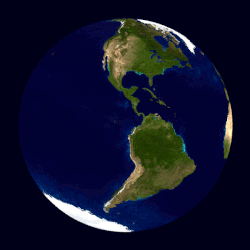Axial tilt
In astronomy, axial tilt is the angle between a planet's rotational axis at its north pole and a line perpendicular to the orbital plane of the planet. It is also called axial inclination or obliquity. The axial tilt of Earth is the cause of seasons like summer and winter on Earth.
Axial tilt of bodies in the Solar System

|

| |
To understand axial tilt, we employ the right-hand rule. When the fingers of the right hand are curled around in the direction of the planet's rotation, the thumb points in the direction of the north pole
| ||
Axial tilt of Venus, Uranus, Pluto
The axial tilts of Venus, Uranus and Pluto are greater than 90 degrees for the following reasons:
- Venus: Venus is rotating very slowly in a retrograde direction, opposite to the direction of planets like Earth. The north pole of Venus is pointed 'down' (southward); hence the angle between the rotational axis of Venus passing through its north pole and the line perpendicular to its orbital plane is 177.4 degrees. There are various theories as to why this is. Its rotation and lack of a moon may be explained by gigantic impacts early in its life.[1]
- Uranus: Uranus, the blue planet, rotates on its side. One result of this axis orientation is that, averaged over the Uranian year, the polar regions get more energy from the Sun than its equatorial regions. Nevertheless, Uranus is colder at its poles than at its equator. What causes this is unknown. The reason for Uranus's unusual axial tilt is also not known for sure, but the usual idea is that during the formation of the Solar System, an Earth-sized protoplanet collided with Uranus, causing the skewed orientation.[2]
- Pluto: Like Uranus, Pluto's rotational axis and north pole are pointed slightly downward (southward). Hence the angle between Pluto's rotational axis passing through its north pole and the line perpendicular to its orbital plane is 119.61 degrees.[3]
Axial Tilt Media
An illustration of axial parallelism. The axis of Earth remains oriented in the same direction with reference to the background stars regardless of where it is in its orbit. Northern hemisphere summer occurs at the right side of this diagram, where the north pole (red) is directed toward the Sun, winter at the left.
Obliquity of the ecliptic for 20,000 years, from Laskar (1986). The red point represents the year 2000.
Related pages
References
- ↑ Musser, George (October 2006). Double impact may explain why Venus has no moon. Scientific American. http://www.sciam.com/article.cfm?articleID=0008DCD1-0A66-152C-8A6683414B7F0000&ref=sciam. Retrieved 2011-12-05.
- ↑ Bergstralh, Jay T; Miner, Ellis & Matthews, Mildred (1991). Uranus. pp. 485–486. ISBN 0-8165-1208-6.
{{cite book}}: CS1 maint: multiple names: authors list (link) - ↑ NASA Planetary Fact Sheet



